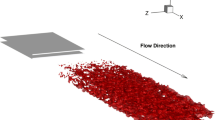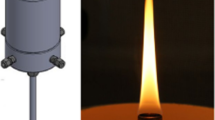Abstract
The goal of this work is to perform parameter estimation by comparing a Reduced Order Model (ROM), built using Proper Orthogonal Decomposition (POD) and Gaussian Process Regression (GPR), with a Sparse Sensing (SpS) model. This framework is demonstrated by selecting the optimal set of the Partially Stirred Reactor (PaSR) coefficients used in the modelling of the Cabra flame. The Cabra flame is a methane flame in a vitiated coflow, consisting of the combustion products of hydrogen and air. The PaSR model necessitates the knowledge of 4 scalar coefficients, which are unknown a priori. To select the optimal set of coefficients, 57 simulations were performed with a different combination of PaSR coefficients. These simulations were used to build the ROM via POD and GPR. To compare the numerical solution with the experimental data, the SpS technique has been employed. SpS is a framework that leverages dimensionality reduction to predict the state of the system given few measurements. The optimal coefficients have been estimated by applying an optimization algorithm to the ROM, using the solution provided by SpS as target. Finally, the data assimilation framework has been used to provide a solution with lower uncertainty bounds. The results show that this framework is able to estimate the optimal set of coefficients, and it can be used to identify residual sources of uncertainty in the numerical model by highlighting the difference between the optimized model and the experimental values.









Similar content being viewed by others
References
Amaduzzi, R., Bertolino, A., Özden, A., et al.: Impact of scalar mixing uncertainty on the predictions of reactor-based closures: application to a lifted methane/air jet flame. Proc. Combust. Inst. (2022). https://doi.org/10.1016/j.proci.2022.06.028
Aversano, G., Bellemans, A., Li, Z., et al.: Application of reduced-order models based on pca & kriging for the development of digital twins of reacting flow applications. Comput. Chem. Eng. 121, 422–441 (2019). https://doi.org/10.1016/j.compchemeng.2018.09.022
Aversano, G., Parra-Alvarez, J.C., Isaac, B.J., et al.: Pca and kriging for the efficient exploration of consistency regions in uncertainty quantification. Proc. Combust. Inst. 37(4), 4461–4469 (2019)
Aversano, G., Ferrarotti, M., Parente, A.: Digital twin of a combustion furnace operating in flameless conditions: reduced-order model development from cfd simulations. Proc. Combust. Inst. 38(4), 5373–5381 (2021). https://doi.org/10.1016/j.proci.2020.06.045
Brunton, S.L., Kutz, J.N.: Data-Driven Science and Engineering: Machine Learning, Dynamical Systems, and Control. Cambridge University Press (2019). https://doi.org/10.1017/9781108380690
Cabra, R., Chen, J.Y., Dibble, R., et al.: Lifted methane-air jet flames in a vitiated coflow. Combust. Flame 143(4), 491–506 (2005). https://doi.org/10.1016/j.combustflame.2005.08.019
Candes, E.J., Tao, T.: Near-optimal signal recovery from random projections: universal encoding strategies? IEEE Trans. Inf. Theory 52(12), 5406–5425 (2006). https://doi.org/10.1109/TIT.2006.885507
Chomiak, J.: Combustion a study in theory, fact and application (1990). https://www.osti.gov/biblio/5894595
European Commission A hydrogen strategy for a climate-neutral Europe (2020)
FiReSMOKE, a collection of finite-rate chemistry solvers for combustion simulations for openfoam (2022.) https://github.com/burn-research/FiReSMOKE
Gastpar, M., Dragotti, P.L., Vetterli, M.: The distributed karhunen-loève transform. IEEE Trans. Inf. Theory 52(12), 5177–5196 (2006). https://doi.org/10.1109/TIT.2006.885449
Gkagkas, K., Lindstedt, R.: Transported pdf modelling with detailed chemistry of pre- and auto-ignition in ch4/air mixtures. Proc. Combust. Inst. 31(1), 1559–1566 (2007). https://doi.org/10.1016/j.proci.2006.08.078
Gordon, R.L., Masri, A.R., Pope, S.B., et al.: Transport budgets in turbulent lifted flames of methane autoigniting in a vitiated co-flow. Combust. Flame 151(3), 495–511 (2007). https://doi.org/10.1016/j.combustflame.2007.07.001
Janicka, J., Kolbe, W., Kollmann, W.: Closure of the transport equation for the probability density funcfion of turbulent scalar fields 4(1), 47–66 (1979). https://doi.org/10.1515/jnet.1979.4.1.47
Kalman, R.E.: A new approach to linear filtering and prediction problems. J. Basic Eng. 82(1), 35–45 (1960). https://doi.org/10.1115/1.3662552
Manohar, K., Brunton, B.W., Kutz, J.N., et al.: Data-driven sparse sensor placement for reconstruction: demonstrating the benefits of exploiting known patterns. IEEE Control Syst. Mag. 38(3), 63–86 (2018). https://doi.org/10.1109/MCS.2018.2810460
Michel, J.B., Colin, O., Angelberger, C., et al.: Using the tabulated diffusion flamelet model adf-pcm to simulate a lifted methane-air jet flame. Combust. Flame 156(7), 1318–1331 (2009). https://doi.org/10.1016/j.combustflame.2008.12.012
Parente, A., Sutherland, J.C.: Principal component analysis of turbulent combustion data: data pre-processing and manifold sensitivity. Combust. Flame 160(2), 340–350 (2013). https://doi.org/10.1016/j.combustflame.2012.09.016
Péquin, A., Iavarone, S., Malpica Galassi, R., et al.: The partially stirred reactor model for combustion closure in large eddy simulations: physical principles, sub-models for the cell reacting fraction, and open challenges. Phys. Fluids 34(5), 055122 (2022). https://doi.org/10.1063/5.0090970
Peters, N.: Laminar flamelet concepts in turbulent combustion. Symp. Int. Combust. 21(1), 1231–1250 (1988). https://doi.org/10.1016/S0082-0784(88)80355-2
Procacci, A., Amaduzzi, R., Coussement, A., et al.: Adaptive digital twins of combustion systems using sparse sensing strategies. Proc. Combust. Inst. (2022). https://doi.org/10.1016/j.proci.2022.07.029
Rasmussen, C.E., Williams, C.K.I.: Gaussian processes for machine learning (adaptive computation and machine learning). The MIT Press (2005). https://doi.org/10.5555/1162254
San Diego Mechanism web page, Mechanical and Aerospace Engineering (Combustion Research), UCSD, Chemical-Kinetic Mechanisms for Combustion Applications (2021). https://web.eng.ucsd.edu/mae/groups/combustion/mechanism.html
Storn, R., Price, K.: Differential evolution-a simple and efficient heuristic for global optimization over continuous spaces. J. Glob. Optim. 11(4), 341–359 (1997). https://doi.org/10.1023/A:1008202821328
Strutz, T.: Data fitting and uncertainty: a practical introduction to weighted least squares and beyond. Springer (2011)
van Oijen, J., Donini, A., Bastiaans, R., et al.: State-of-the-art in premixed combustion modeling using flamelet generated manifolds. Prog. Energy Combust. Sci. 57, 30–74 (2016). https://doi.org/10.1016/j.pecs.2016.07.001
Xiao, M., Breitkopf, P., Filomeno Coelho, R., et al.: Model reduction by CPOD and kriging. Int. J. Struct. Multidisc. Optim. 41, 555–574 (2009)
Funding
This publication benefits from the support of the Walloon Region as part of a FRIA grant funding. This project has also received funding from the European Research Council (ERC) under the European Union’s Horizon 2020 research and innovation program under grant agreement No. 714605.
Author information
Authors and Affiliations
Corresponding author
Ethics declarations
Conflict of interest
The authors have no relevant financial or non-financial interests to disclose.
Rights and permissions
Springer Nature or its licensor (e.g. a society or other partner) holds exclusive rights to this article under a publishing agreement with the author(s) or other rightsholder(s); author self-archiving of the accepted manuscript version of this article is solely governed by the terms of such publishing agreement and applicable law.
About this article
Cite this article
Procacci, A., Donato, L., Amaduzzi, R. et al. Parameter Estimation Using a Gaussian Process Regression-Based Reduced-Order Model and Sparse Sensing: Application to a Methane/Air Lifted Jet Flame. Flow Turbulence Combust 112, 879–895 (2024). https://doi.org/10.1007/s10494-023-00446-x
Received:
Accepted:
Published:
Issue Date:
DOI: https://doi.org/10.1007/s10494-023-00446-x




